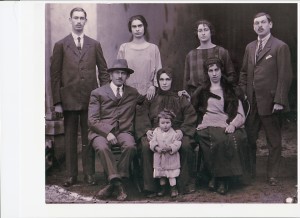A Shoah Legacy
My cousin sent me a photograph a few years ago that I had never seen before. Eight people are gathered together in their finest garments to pose for a family photograph. None of them are smiling yet they all look content and proud.
The three men in the photo are dressed in what must have surely been their best clothes, dark suits and ties, all with tidy mustaches. The two younger men are standing on the dirt floor of the photographer’s studio, but an older man is sitting down in front of them, a fedora hat atop his head, his left hand draped over what must be his wife’s shoulder. His wife wears a long black coat covering her entire body with a dark kerchief hiding her hair. A younger woman sits next to them facing the camera with a smug grin, probably pleased with the fox fur status symbol she wears around her neck. A young girl, perhaps three years old, with a bow in her hair stands in front of the mother.
I only met one person who posed for this photograph taken in the 1920’s, a tall slender woman wearing a light-colored dress who stands among the two younger men and another young woman. It was many years later, soon after arriving in America, when my mother and I went to visit my distant cousin Eleanor in the Bronx, New York. She had left that small city in Hungary just a few years after the photograph was taken to join another sister who had made the trip earlier. What happened to the other seven who posed that day for the family photo, the proud mother and father and their children? All lost in the Shoah.
Why do I care about this photograph so much? Even though it is a picture of my great, great uncle and his family, it’s the only one I have of my ancestors in Hungary. It’s the closest I will ever come to knowing what my mother’s family must have looked like in the country where they lived for many generations. My mother, Sidonia, is also gone now after living in America for almost sixty years, but I can see her face in the faces of these distant relatives. And what’s more, I can see my own.





